Horror author Adam L. G. Nevill was born in Birmingham, England in 1969 and grew up in New Zealand and England. His novels The Ritual, Last Days, No One Gets Out Alive, and The Reddening all won the August Derleth Award for Best Horror Novel.
He currently lives in Devon, England, with his family and is set to release his next book on Halloween later this year.
“All I’m prepared to disclose about my new book, at this stage, is that those who enjoyed The Ritual and The Reddening, may enjoy this new story,” Nevill teases.
“Far more detail is coming soon, in my monthly newsletter first. If you sign up, you get a free book, too.”
(Readers who sign up for his newsletter get a free eBook, Cries from the Crypt.)
Nevill is one of the shining examples of self-published modern horror after taking a leap of faith in 2017 after Under a Watchful Eye. His recommendations to writers are pretty simple, and he also stresses that the end products are quite fulfilling:
“Create a best practice and always maintain quality control as a writer and as a press. Writing should not be about title count but quality. There is a prescribed method for producing good editions of books. This critical path is necessary; it's time-honored, so stick to it. To publish well, you'll be spending a significant amount of time publishing, doing admin, and marketing. Maybe nearly half your time. Invest in two proofreads.”
Nevill finishes his self-publishing recommendations by ringing a clear warning bell to the horror community:
“AI is going to be the devil in books. Avoid it. Don't cheat.”
The Lineup interviewed Nevill via email about his memories of all his novels and a curated selection of his short story collections, as well as even Imaginarium’s film adaptations of The Ritual and No One Gets Out Alive.
Whether you're an avid Adam Nevill reader or just stumbling upon his stories, these books are an excellent place to begin your descent into his various swathes of modern folk and occult horror.
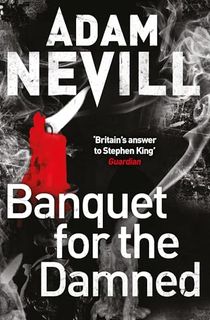
Banquet for the Damned (2004)
The initial spark for the characters Dante and Tom in Nevill’s first novel Banquet of the Damned was “two best friends who resented each other.”
The author evolves this emotional tug of war between male friends again in The Ritual, but Banquet is a bit of a spiritual prequel as it's set in Scotland’s oldest university town, St Andrews on the east coast of Fife.
Young men and women haunted by terrible dreams are vanishing from their beds, and body parts are washing up from the German Sea (an older name for the North Sea).
Nevill honed in on one particular character for the sadistic and exploitative coven at the heart of the plot. That character is Professor Eliot Coldwell, the notorious magician and besmirched author of Banquet for the Damned.
“I used a charismatic, erudite, worldly character that people found alluring,” says Nevill.
“But he was also Machiavellian and narcissistic and felt little empathy for the victims of his excesses and experiments. Coldwell always had power over others, until he lost that control to something far more powerful than himself. In one way, everything that happens in the story is the chaos left in the wake of this one man's arrogance, self-deception, and entitlement. What makes him even more loathsome is the awe the young feel for him and the trust they invested in him.”
Nevill’s Banquet of the Damned is a ripping good yarn for those that want to get an early taste of his particular brand of small town occult horror where unlikely heroes emerge with ratcheting tension along the way.
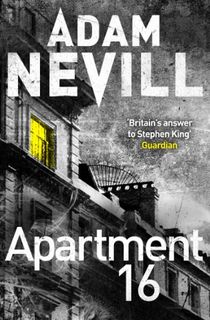
Apartment 16 (2010)
Apartment 16 follows the story of Lillian, who becomes a hoarder after her husband’s death. Nevill was inspired by his experience and observations while working as a front-of-house porter in the West End of London.
“In one building in Mayfair, there were two elderly residents who inspired Lillian; one lived in a flat that hadn't changed since the Second World War; another had dementia, roamed as if she were trying to escape, and collected dead flowers,” recalls Nevill.
“Taxi drivers used to spot her and drive her back to the building. Tragic and sad. I became curious about their histories. They'd lived long lives.”
The setting in London takes on a mind of its own in Apartment 16’s story. Nevill wanted the city to be oppressive and maddening. The novel is primarily told via the viewpoints of Apryl, a young American woman, and Seth, an English porter and artist.
Apryl and her mother have recently inherited Lillian’s estate, Apryl's great aunt, which includes an apartment at an exclusive London building. She's horrified to discover that her great aunt spent her final years in squalor and mental instability.
“Seth's entire perception of the city and its inhabitants becomes abstract, like a living, nightmarish expressionist painting,” says Nevill.
The author was also fascinated by artists compelled to be original and pursue “a vision or truth, at all costs, even if ruin and penury seemed inevitable; and how even derengagement was a vital part of these leaps of faith.”
Apartment 16 is all about a descent into mad ideas spurred on by unhappy individuals in hopeless circumstances. Nevill calls it the “outsider or misfit conundrum.”
The constricting control a hooded character starts to have over the dejected Seth throughout the novel befits the original title Nevill had for the book, which was not approved by the publisher: Down Here With the Rest of Us.

The Ritual (2011/2012)
For many readers, The Ritual is their favorite Nevill work so far. The novel transplants the British concept of folk horror into Scandivania through the lens of a group of men testing their camaraderie to its very limits.
University friends Dom, Phil, Luke, and Hutch reunite on a hiking trip through the Swedish mountains in the book.
The squabbling foursome comes across a desiccated shack crammed with ritualistic artifacts and bones. The friends also stumble upon a forsaken church, desanctified and repurposed for pagan practices.
The group is inspired by Nevill’s observations of male friend groups over the years.
“Men can become disproportionately competitive, and this takes various forms, either subtle or obvious,” Nevill observes.
“Someone is always seeking dominance in a group situation, too. Ultimately, men often try to restore what they see as an equivalency, but if this involves demoting the envied friend in some way, that relationship is screwed. And I think true and enduring male friendship is often founded on feeling a sense of joy at another's accomplishments or actions.”
Nevill is quite happy with the ardent reactions to the book, even if he thinks the book is closer to cosmic horror.
“When I wrote most of the book, in 2008, I intended no conscious affinity with the classics in the [folk horror] canon like The Wicker Man, or Blood on Satan's Claw, or Witchfinder General. Doubt I even gave them a single thought,” remembers Nevill.
“I was more interested in the terrible but awesome enigma of an ancient, near-forgotten deity still existing. I felt the story was more in the realm of Lovecraft and also Blackwood's The Willows; from modern authors, The Ruins by Scott Smith and Deliverance by James Dickie shone a light on how such a story could be attempted.”
Nevill also enjoys the 2017 film adaptation, directed by David Bruckner and starring Rafe Spall and Robert James-Collier.
“The aesthetic is superb, as is one of the god's scenes that actually gave me a sense of awe and wonder. I was very impressed with Joe's characterisation and dialogue, and David is a fantastic director. The actors are terrific, and I love the score, too."
The director told Nevill that he saw four films in the novel, but he could only make one. He probably sees a mention of the film every week online, which is a particular point of pride for him to this day.

Last Days (2012/2013)
Last Days follows Kyle Freeman, a guerrilla documentary filmmaker who is hired to film the cult, Temple of the Last Days.
Nevill dove into a lot of desk research for this particular novel, citing the Manson Family, Jonestown, and The Process Church of the Final Judgement as “key modern examples of how cults work, rise, and inevitably fall.”
From history, Nevill also analyzed the Anabaptists and Millennial cults, and the Mormon Church.
The Temple’s sadistic cult leader, Sister Katherine, is one of his more unique characters, and Nevill pulled from his personal experience and investigations. He chose a female villain instead of the typical male cult leader for a variety of reasons.
“Well, I'm not a psychologist, but I'm pretty sure by that point that I'd encountered several genuine female psychopaths; compulsive narcissists who did significant and lasting harm to people and organizations,” he says.
For the depictions of cruelty and violence in the story, Nevill always wants each scene to feel credible, but not push into ludicrity.
“A reader has to feel the teeth break the skin,” Nevill recommends.
“Otherwise, you're making a cartoon. And if you overwrite these scenes, again, you're making a cartoon. Choose your diction carefully, and it needs to be sensory, emotive. I often think that although horror needs to be entertaining, part of it shouldn't be. You need to be unseated and disturbed in a way that is not pleasurable. I've always pivoted between the two intentions.”
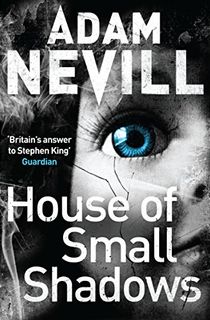
House of Small Shadows (2013/2014)
When Nevill finished writing House of Small Shadows, he “felt as if I had conducted a strange ritual.”
Architecture, taxidermy, doll and puppet making, and the Great War all coalesce for the folklore and history surrounding the haunted Red House.
Nevill calls this “weird book” a “story of a woman being returned, against her will, to the magic, enchantment, and nightmares of her childhood.”
For Nevill, it’s a haunted house story that is more interested in how childhood memories often haunt adults.
“As I've grown older, I've become aware that really powerful memories from childhood are dimming, even vanishing, and imagined scenarios that may never have happened, and daydreams and terrors, and what's left of the weird abstract world that my imagination inhabited back then. I wanted to capture a sense of my consciousness in my first ten or so years before that part of me vanished,” Nevill reflects.
Nevill enjoyed how strange the final book was in comparison to his other novels.
“I really pushed the boat out and explored my childlike strangeness. I did this abstractly and not literally or biographically. I found new symbols and metaphors for my own experiences and memories.”
The concept of items in homes that contain ghosts from the past makes House of Small Shadows a unique gem in Nevill’s works.
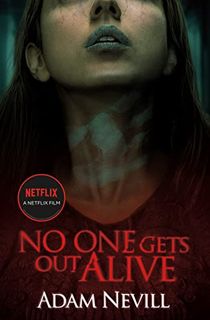
No One Gets Out Alive: A Novel (2014/2015)
No One Gets Out Alive is a supernatural thriller in Birmingham’s Perry Barr neighborhood, where Stephanie works various temp jobs and stares at many tough bank statements.
This is directly pulling emotional threads from Nevill’s early life as a struggling writer living in destitute city apartments.
“All of my settings become characters and exude an influence over the occupants, or issue presences; it's one facet of horror that I adore and that sets it apart from other types of fiction,” Nevill reflects.
No One Gets Out Alive is a story that gets under your skin with its exacting commentary about living an indigent life.
“I think the commentary is self-evident on the consequences of transience, deprivation, circumstances, and situations compelled by poverty, loneliness, our subsequent vulnerability to the predatory and unscrupulous. Being miserable and broke is a full-time occupation; it takes all of you. But Stephanie shows immense courage, resilience, and agency in the face of it all.”
Nevill also enjoyed the movie adaptation of No One Gets Out Alive, despite some criticisms from some horror aficionados. “The acting is generally terrific; Cristina [Rodlo] is superb as Ambar.”
I love the atmosphere and the god. And a lot of people have watched the film, tens of millions.”
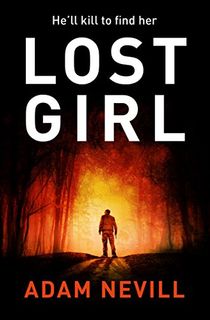
Lost Girl (2015)
Lost Girl is set in 2053 in a world decimated by severe climate change, pandemics, and rising geopolitical violence.
It follows a man whose four-year-old daughter was kidnapped two years ago, and the authorities fail to help him. Nevill wanted to capture his parental obsessions with his daughter’s safety and anxieties about her future.
“This gave me everything I needed, and it was a hard and emotional book to write, " Nevill remarks.
The book also slices into the fears of modern society like a sharp knife.
“There's a great neo-religious terror of death, which is sweeping the planet in an epochal dieback of every species. Everything that is happening is an augur of something much worse in the near future. So, this is a slipping back to feudalism, and pre-antibiotics. But it's not a nihilistic story. Though the only light remaining seems to be parental love and childhood innocence, and the courage of a handful of people who stand up to a remorseless, relentless tide of chaos and depravity."
Nevill’s advice to new fathers and mothers is quite simple: “Stick to your values. But think everything through to the end.”
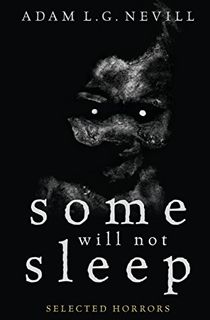
Some Will Not Sleep: Selected Horrors (2016)
Some Will Not Sleep is Nevill’s first short story collection and one of his many works that have either won or been shortlisted for a British Fantasy Award. He wanted this grouping of stories to make readers feel disturbed first and foremost.
“As a horror writer, generally, the challenge I have always set myself is to try and conjure the power of short stories within novels,” Nevill states.
“The maxim that the short story is the ideal form for horror and that the novel is a completely different medium is something that I do not agree with. They coexist in harmony; the former is good training for the latter, and every line of the latter should strive to be as considered as every line in the former.”
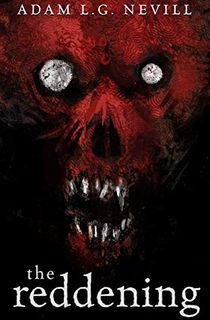
The Reddening (2019)
The Reddening is set in the coastal area of South Devon, where Adam Nevill and his family currently live. He loves the historicity of the region.
“Every age of the Earth can be seen in our cliffs in South Devon, and some of the most important prehistoric finds were discovered here in caves,” he says. The next three novels are also Devon novels since they were written in Devon.
“So, aesthetically, right from the start of my career, I've had an affinity for the pagan, the occult, ritual magic, cosmic horrors, the supernatural: it's what I write about, and it offers the perfect vehicle to carry my stories and ideas.”
The main characters, lifestyle journalist Katrine and the solo parent Helene, are both escaping past traumas in the book and escaping to the coast. Nevill wanted their stories to feel credible and intriguing, like Stephen King’s best characters do so well.
“I rarely create exceptional people as characters, which may go against the grain of most genre fiction. But in horror, I suspect, much appeal arises from ordinary characters who draw us, as readers, into the stories. Stephen King is the greatest writer of characters in horror. I can't think of one of his stories in which I haven't immediately understood a character and been intrigued. And he depicts them all so vividly from the inside out. I'm in awe of that.”
One of the more unique characters in the book is the Witchfinder Apprentice, who was inspired by the ‘70s British folk rock band Steeleye Span and a little Jethro Tull and Black Sabbath.
“It was British folk with added doom,” Nevill adds. These everyday characters are pulled into an epic story of mythical “red folk” and prehistoric horrors.

Wyrd and Other Derelictions
Wyrd and Other Derelictions is one of Nevill’s most unique short story collections. Its general setup is that each story is without characters.
The writer was preoccupied with the very real reality of human extinction after Lost Girl and then wrote a “wyrd” tale without characters called “Hippocampus.” Over the years, he wrote more “derelictions.”
The difficulties with this writing prompt were thought-provoking, and he thinks the finished project is an acquired taste, but he’s glad he saw the project to its completion.
“They're always going to be dense and intense narratives; that was the first lesson,” Nevill remembers.
“I also learned that even without characters, or anyone living within a piece, the actual stories are far stronger than I imagined that they could be. Even emptiness and stasis, around evidence, prompt narrative. Situations, objects, the material nature of a setting, a lingering atmosphere, immediately create narrative. I think the technique could tell a story in any genre.”
Two other lessons surfaced after completing this collection for Nevill: narrators for stories are very necessary even without human characters, and he loves being able to truly experiment within the genre of horror since he self-publishes his books.

Cunning Folk (2021)
Cunning Folk explores the notion of a house as a prison for a family, in particular a regular dad Tom, and his fight with the cunning witches next door. Tom is not a handyman at all and is fighting internal battles within his house beyond fixing its many broken items.
Nevill thinks all houses, in a sense, are “cursed by hidden faults, wear, DIY disasters from previous owners, neighbors.”
Tom wants the best for his family, but by putting so much daily pressure on himself, he’s prone to entropy just like his home. Walls crack. Wood rots. A mind can unspool.
“I get a real sense that most people are just boiling with dissatisfaction and frustration and rage, most of the time,” Nevill comments. “Tom is a critical mass of this. People can only be pushed so far—or, can only push themselves so far—until they break. Then, anything can happen.”

The Vessel (2022)
The Vessel is all about survival on psychological and physiological levels. It started as a 2018 screenplay before it turned into a novella, with not too many changes along the way.
As with The Reddening, Wyrd and Other Derelictions, Cunning Folk, and All the Fiends of Hell, The Vessel’s cover features art from Samuel Araya. Nevill originally met Sam when he created a painting inspired by The Ritual on his own.
“I became aware of this and asked if I could buy a print,” Nevill remembers. “We got talking. Sam was a reader of my horrors, and I was a big admirer, anyway, of his work.”
For the first novel published through Ritual Limited—The Reddening—Nevill asked Araya to make the cover art, and they never looked back.
“His art is so powerful and affecting, I decided that the limited editions would only feature his work on the book jackets. It's become an exciting and permanent collaboration. Receiving his sketches for each new book is my favourite part of the publishing process.”
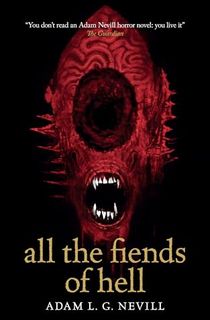
All the Fiends of Hell
If you ask Adam Nevill, nothing beats H.G. Wells’ War of the Worlds.
He also thoroughly enjoys Invasion of the Body Snatchers, in book and film. The Thing, the Alien series of films, particularly of Covenant and its origin story, Close Encounters of the Third Kind, and Signs.
All the Fiends of Hell is a harrowing alien invasion narrative. Its main character Karl is one of Nevill’s best characters and follows in the lineage of the best kinds of Stephen King protagonists.
He’s a lonely and unremarkable guy who somehow survives the first day of the invasion (night of the bells) and is paired up with two grieving kids he has to protect and console. Nevill is relieved by the reactions so far to Karl since he was such a creative risk.
“A lost soul discovering a suppressed moral character and great sense of responsibility, that even reduces the value of his own life to having less value than two young strangers, was a powerful idea that I wanted to explore,” Nevill remarks on Karl.
A male character completely out of their depth and stumbling into success is a returning theme for Nevill.
“He couldn't be a parent, nor could the character be a mother with innate maternal instincts; that was too known. I wanted the epitome of male inaction and inertia, even immaturity, to transcend to a higher ideal of what a man can be. And he has to sort himself out quickly, because that big clock in the red sky is ticking fast."
All the Fiends of Hell is a beautiful reflection of endearing characterizations in the face of ugly horrors from outer space.
Featured photo: Nightmare-magazine.com













